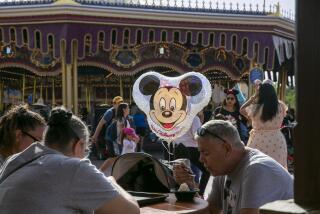Mouse in the House : Bernie Shine’s Entire Home Is Full of Mickey Mouse Memorabilia--and That Still Isn’t Enough
- Share via
As a personal-injury lawyer, Bernie Shine of Los Angeles has an ordinary business card. But he also carries another card, one bearing a colored picture of Mickey Mouse in a top hat. It is printed: “Bernard C. Shine. Mickeyologist. Collector of early Disney artifacts.” He calls it his “collecting card.” Bernie Shine collects Mickey mice and other Disney characters. He thinks Donald Duck is more interesting, psychologically, than Mickey; Donald figures and other items are also rarer than Mickeys, because parents thought the irascible duck was a less suitable role model for their children and so bought fewer Donalds. But Mickey Mouse is Bernie Shine’s obsession.
In 1969, Shine bought a Mickey Mouse watch (the first Mickey watch, designed in 1932 and issued in 1933) for a small sum in a thrift shop. He sold it for a good profit. Then he began to see television stars such as Johnny Carson wearing Mickey Mouse watches, and he wished he hadn’t sold his. He looked around for another. It wasn’t easy to find. A few avant-garde people were beginning to appreciate Mickey as pop art, but Mickeyana had not yet graduated from the thrift shops to the Art Deco and antique shops. (Today an early Mickey watch will set you back about $150.) Eventually Shine found one--at a price. Since 1970, Shine has been a committed, insatiable Mickey Mouse collector.
His walls are lined with Mickey Mouse dolls, games, bucket-and-spade sets, bisque figures, toy trains, badges, buttons, posters, comics and annuals. Even the bathroom is awash with Mickeyana. Some of the Mickey dolls, somewhat rat-like, were made in Nuremberg; but those are rare, because Hitler banned Mickey after seeing a Disney cartoon that he took to be anti-German. (Mussolini, by contrast, was a Disney fan, and a letter from him is preserved in the museum at Disney Studios.) Other dolls were made in Los Angeles by Charlotte Clark, under license from Walt Disney, who liked to pose for press photographs with an assortment of the dolls. The finest Mickey and Minnie Mouse dolls were exported between 1931 and 1934 by the German manufacturer Marguerite Steiff.
The popularity of Mickey in the 1930s saved some companies from ruin. The Ingersoll Watch Co. was just ticking over when a big demand for Mickey watches brought life-saving profits. The Lionel Corp., which made toy trains, went into receivership in 1934 but was lifted out of it in 1935 by the sales of a small handcart that Mickey and Minnie pumped around a circular track. Disney’s trade representative, Kay Kamen, exploited the episode in advertisements: “Red to Black on a Handcar--Mickey Mouse Pulls That Way.”
Bernie Shine is picky about Mickey. He collects only those Mickey Mouse artifacts that date from 1932 to 1938. In that period, Mickey still had a tail. He also had a white face with what collectors call pie eyes --like two black pies with a slice out of each. And he had a bare torso. After 1938 Disney decided to “humanize” Mickey. The mouse was given eyeballs and a shirt. In Shine’s disgusted view, Mickey was thus transformed from a robust, daredevil character into merely a cutesy logo. Shine quotes with approval artist Ernest Trova: “I don’t relate to Mickey as a rodent but as a comic character of grand proportion. Along with the swastika and the Coca-Cola bottle, Mickey Mouse is the most powerful graphic image of the 20th Century.”
More to Read
Sign up for The Wild
We’ll help you find the best places to hike, bike and run, as well as the perfect silent spots for meditation and yoga.
You may occasionally receive promotional content from the Los Angeles Times.






